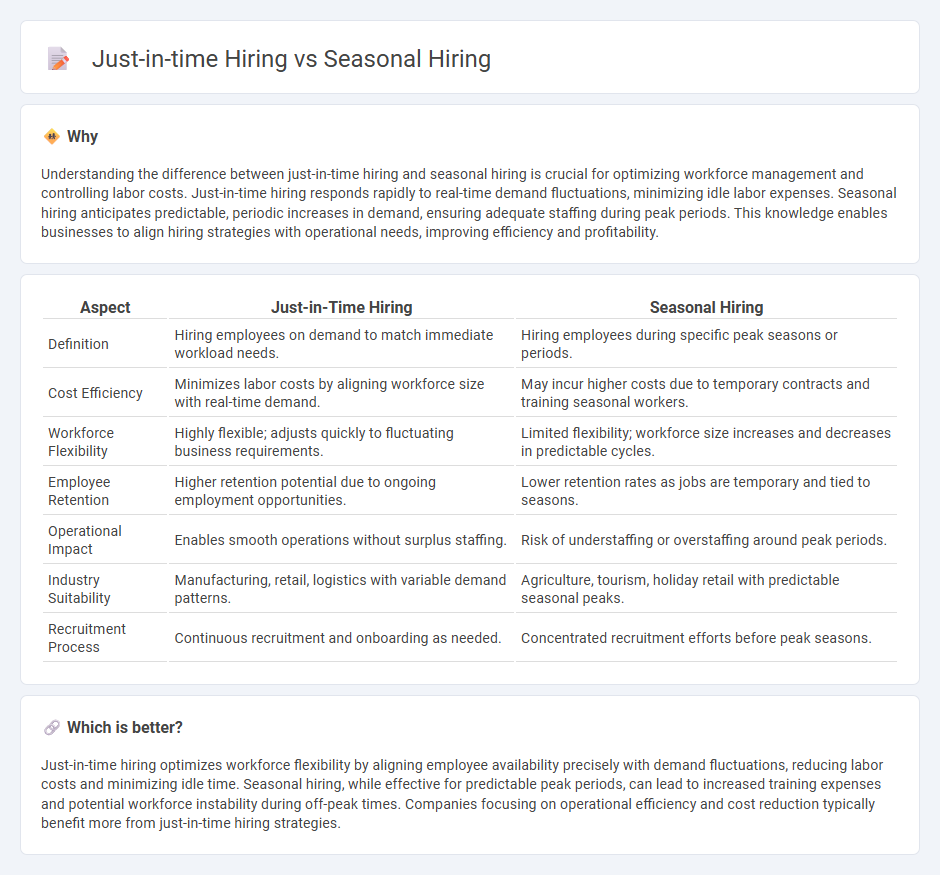
Just-in-time hiring optimizes workforce costs by recruiting employees precisely when labor demand peaks, reducing idle staff expenses. Seasonal hiring focuses on temporary recruitment aligned with predictable fluctuations in business cycles, such as holidays or harvest periods, to manage short-term workload spikes efficiently. Explore the advantages and challenges of these hiring strategies to enhance business agility and labor cost management.
Why it is important
Understanding the difference between just-in-time hiring and seasonal hiring is crucial for optimizing workforce management and controlling labor costs. Just-in-time hiring responds rapidly to real-time demand fluctuations, minimizing idle labor expenses. Seasonal hiring anticipates predictable, periodic increases in demand, ensuring adequate staffing during peak periods. This knowledge enables businesses to align hiring strategies with operational needs, improving efficiency and profitability.
Comparison Table
| Aspect | Just-in-Time Hiring | Seasonal Hiring |
|---|---|---|
| Definition | Hiring employees on demand to match immediate workload needs. | Hiring employees during specific peak seasons or periods. |
| Cost Efficiency | Minimizes labor costs by aligning workforce size with real-time demand. | May incur higher costs due to temporary contracts and training seasonal workers. |
| Workforce Flexibility | Highly flexible; adjusts quickly to fluctuating business requirements. | Limited flexibility; workforce size increases and decreases in predictable cycles. |
| Employee Retention | Higher retention potential due to ongoing employment opportunities. | Lower retention rates as jobs are temporary and tied to seasons. |
| Operational Impact | Enables smooth operations without surplus staffing. | Risk of understaffing or overstaffing around peak periods. |
| Industry Suitability | Manufacturing, retail, logistics with variable demand patterns. | Agriculture, tourism, holiday retail with predictable seasonal peaks. |
| Recruitment Process | Continuous recruitment and onboarding as needed. | Concentrated recruitment efforts before peak seasons. |
Which is better?
Just-in-time hiring optimizes workforce flexibility by aligning employee availability precisely with demand fluctuations, reducing labor costs and minimizing idle time. Seasonal hiring, while effective for predictable peak periods, can lead to increased training expenses and potential workforce instability during off-peak times. Companies focusing on operational efficiency and cost reduction typically benefit more from just-in-time hiring strategies.
Connection
Just-in-time hiring allows businesses to align workforce supply precisely with demand fluctuations, reducing labor costs and improving operational efficiency. Seasonal hiring complements this by addressing predictable spikes in demand during specific periods, such as holidays or harvest seasons. Together, these strategies optimize labor resources, ensuring companies maintain productivity without excess staff during low-demand intervals.
Key Terms
Labor Flexibility
Seasonal hiring accommodates predictable fluctuations by recruiting temporary workers during peak periods, enhancing labor flexibility without long-term commitments. Just-in-time hiring responds swiftly to immediate labor demands, minimizing idle workforce and optimizing operational efficiency. Explore strategies to balance labor flexibility with cost-effectiveness in dynamic business environments.
Workforce Planning
Seasonal hiring addresses predictable demand spikes by onboarding temporary employees during peak periods, ensuring adequate workforce capacity in industries like retail and agriculture. Just-in-time hiring emphasizes rapid recruitment in response to unexpected or immediate labor needs, optimizing flexibility but requiring agile Talent Acquisition strategies. Explore detailed workforce planning approaches to balance cost-efficiency and operational responsiveness effectively.
Demand Fluctuation
Seasonal hiring addresses predictable demand fluctuations by recruiting temporary staff during peak periods, ensuring operational efficiency in industries like retail and hospitality. Just-in-time hiring responds to sudden, unpredictable demand spikes with rapid recruitment, minimizing labor costs but potentially risking workforce preparedness. Explore the advantages and challenges of each hiring strategy to optimize workforce management in fluctuating markets.
Source and External Links
Seasonal Employment - NYSDEC - Offers summer jobs at campgrounds in the Adirondack Mountains and Catskill Forest Preserves, with direct hiring by regional offices for most roles.
Seasonal Jobs in Elmira, NY (NOW HIRING) - ZipRecruiter - Lists over 40 current seasonal job openings in Elmira, NY, including roles like seasonal sales associate with hourly rates from $16-$20.
Seasonal Jobs @ Amazon Search Results - Amazon posts seasonal warehouse roles nationwide, offering flexible schedules, weekly pay, overtime, and instant pay access with a fast, interview-free application process.
 dowidth.com
dowidth.com